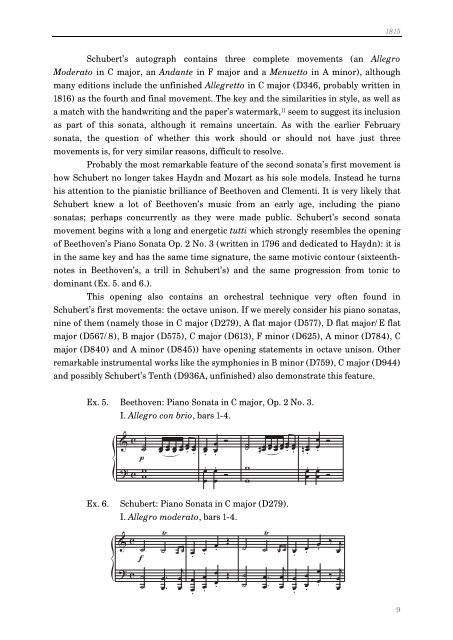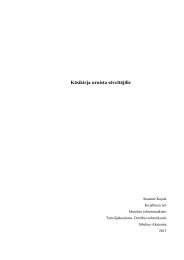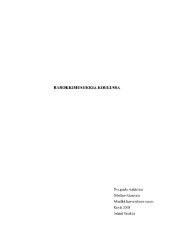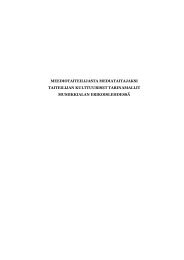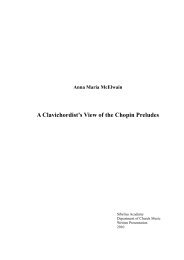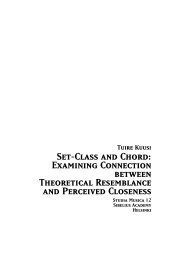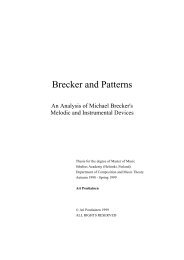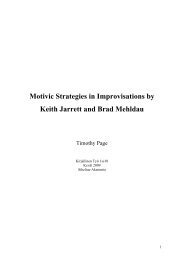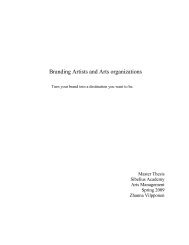The Unfinished Piano Sonatas of Franz Schubert Javier ... - Ethesis
The Unfinished Piano Sonatas of Franz Schubert Javier ... - Ethesis
The Unfinished Piano Sonatas of Franz Schubert Javier ... - Ethesis
Create successful ePaper yourself
Turn your PDF publications into a flip-book with our unique Google optimized e-Paper software.
1815<br />
<strong>Schubert</strong>’s autograph contains three complete movements (an Allegro<br />
Moderato in C major, an Andante in F major and a Menuetto in A minor), although<br />
many editions include the unfinished Allegretto in C major (D346, probably written in<br />
1816) as the fourth and final movement. <strong>The</strong> key and the similarities in style, as well as<br />
a match with the handwriting and the paper’s watermark, 11 seem to suggest its inclusion<br />
as part <strong>of</strong> this sonata, although it remains uncertain. As with the earlier February<br />
sonata, the question <strong>of</strong> whether this work should or should not have just three<br />
movements is, for very similar reasons, difficult to resolve.<br />
Probably the most remarkable feature <strong>of</strong> the second sonata’s first movement is<br />
how <strong>Schubert</strong> no longer takes Haydn and Mozart as his sole models. Instead he turns<br />
his attention to the pianistic brilliance <strong>of</strong> Beethoven and Clementi. It is very likely that<br />
<strong>Schubert</strong> knew a lot <strong>of</strong> Beethoven’s music from an early age, including the piano<br />
sonatas; perhaps concurrently as they were made public. <strong>Schubert</strong>’s second sonata<br />
movement begins with a long and energetic tutti which strongly resembles the opening<br />
<strong>of</strong> Beethoven’s <strong>Piano</strong> Sonata Op. 2 No. 3 (written in 1796 and dedicated to Haydn): it is<br />
in the same key and has the same time signature, the same motivic contour (sixteenthnotes<br />
in Beethoven’s, a trill in <strong>Schubert</strong>’s) and the same progression from tonic to<br />
dominant (Ex. 5. and 6.).<br />
This opening also contains an orchestral technique very <strong>of</strong>ten found in<br />
<strong>Schubert</strong>’s first movements: the octave unison. If we merely consider his piano sonatas,<br />
nine <strong>of</strong> them (namely those in C major (D279), A flat major (D577), D flat major/E flat<br />
major (D567/8), B major (D575), C major (D613), F minor (D625), A minor (D784), C<br />
major (D840) and A minor (D845)) have opening statements in octave unison. Other<br />
remarkable instrumental works like the symphonies in B minor (D759), C major (D944)<br />
and possibly <strong>Schubert</strong>’s Tenth (D936A, unfinished) also demonstrate this feature.<br />
Ex. 5. Beethoven: <strong>Piano</strong> Sonata in C major, Op. 2 No. 3.<br />
I. Allegro con brio, bars 1-4.<br />
& c<br />
˙ œ œ œ œ œ . œ .<br />
p<br />
? c w<br />
œ .<br />
œ .<br />
œ.<br />
œ<br />
œ. œ<br />
Ó<br />
Ó<br />
˙ # œ œ œ œ œ . œ .<br />
w<br />
w<br />
Ex. 6. <strong>Schubert</strong>: <strong>Piano</strong> Sonata in C major (D279).<br />
I. Allegro moderato, bars 1-4.<br />
& c<br />
˙<br />
f<br />
Ÿ<br />
˙<br />
? c ˙<br />
˙<br />
œ .<br />
œ .<br />
œ œ<br />
j<br />
œ<br />
œ<br />
œ .<br />
œ<br />
œ .<br />
œ .<br />
œ<br />
œ .<br />
œ .<br />
œ<br />
œ .<br />
Œ<br />
Œ<br />
Ÿ<br />
˙ ˙<br />
˙<br />
˙<br />
œ .<br />
œ .<br />
œ œ<br />
j<br />
œ<br />
œ<br />
œ .<br />
œ<br />
œ .<br />
n œ.<br />
œ .<br />
œ . œ. œ<br />
œ .<br />
œ<br />
œ .<br />
œ .<br />
œ<br />
œ .<br />
Ó<br />
Ó<br />
‰ j<br />
œ<br />
‰<br />
j<br />
œ<br />
œ<br />
9


